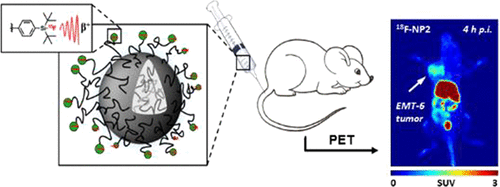当前位置:
X-MOL 学术
›
Bioconjugate Chem.
›
论文详情
Our official English website, www.x-mol.net, welcomes your
feedback! (Note: you will need to create a separate account there.)
18F-Radiolabeling and In Vivo Analysis of SiFA-Derivatized Polymeric Core–Shell Nanoparticles
Bioconjugate Chemistry ( IF 4.0 ) Pub Date : 2017-12-14 00:00:00 , DOI: 10.1021/acs.bioconjchem.7b00630 Sheldon Berke 1 , Anne-Larissa Kampmann 1 , Melinda Wuest 1 , Justin J. Bailey 1 , Britta Glowacki , Frank Wuest 1 , Klaus Jurkschat , Ralf Weberskirch , Ralf Schirrmacher 1
Bioconjugate Chemistry ( IF 4.0 ) Pub Date : 2017-12-14 00:00:00 , DOI: 10.1021/acs.bioconjchem.7b00630 Sheldon Berke 1 , Anne-Larissa Kampmann 1 , Melinda Wuest 1 , Justin J. Bailey 1 , Britta Glowacki , Frank Wuest 1 , Klaus Jurkschat , Ralf Weberskirch , Ralf Schirrmacher 1
Affiliation

|
Nanoparticles represent the most widely studied drug delivery systems targeting cancer. Polymeric nanoparticles can be easily generated through a microemulsion polymerization. Herein, the synthesis, radiolabeling, and in vivo evaluation of nanoparticles (NPs) functionalized by an organosilicon fluoride acceptor (SiFA) are reported which can be radiolabeled without further chemical modifications. Four nanoparticles in the sub-100 nm range with distinct hydrodynamic diameters of 20 nm (NP1), 33 nm (NP2), 45 nm (NP3), and 72 nm (NP4), respectively, were synthesized under size-controlled conditions. The SiFA-labeling building block acted as an initiator for the polymerization of polymer P1. The nanoparticles were radiolabeled with fluorine-18 (18F) through simple isotopic exchange (IE) and analyzed in vivo in a murine mammary tumor model (EMT6). The facile 18F radiolabeling SiFA methodology, performed in ethanol under mild reaction conditions, gave radiochemical yields (RCYs) of 19–26% and specific activities (SA) of 0.2–0.3 GBq/mg. Based on preclinical PET analysis, the tumor uptake and clearance profiles were analyzed depending on particle size. The nanoparticle size of 33 nm showed the highest tumor accumulation of SUVmean 0.97 (= 4.4%ID/g) after 4 h p.i. through passive diffusion based on the Enhanced Permeability and Retention (EPR) effect. Overall, this approach exhibits a simple, robust, and reliable synthesis of 18F radiolabeled polymeric nanoparticles with a favorable in vivo evaluation profile. This approach represents a straightforward synthetically accessible alternative to produce radiolabeled nanoparticles without any further surface modification to attach a radioisotope.
中文翻译:

SiFA衍生的聚合物核-壳纳米粒子的18 F-放射性标记和体内分析
纳米颗粒代表了针对癌症的研究最广泛的药物递送系统。聚合物纳米颗粒可以通过微乳液聚合容易地产生。在此,报道了被有机硅氟化物受体(SiFA)官能化的纳米颗粒(NPs)的合成,放射性标记和体内评估,其可以在没有进一步化学修饰的情况下进行放射性标记。在尺寸控制的条件下,分别合成了亚100 nm范围内的四个纳米颗粒,分别具有20 nm(NP1),33 nm(NP2),45 nm(NP3)和72 nm(NP4)的不同流体动力学直径。SiFA标记的结构单元充当聚合物P1聚合的引发剂。纳米颗粒用氟18(18F)通过简单的同位素交换(IE)并在鼠乳腺肿瘤模型(EMT6)中进行体内分析。在乙醇中,在温和的反应条件下进行的简便的18 F放射性标记SiFA方法,放射化学产率(RCY)为19–26%,比活(SA)为0.2–0.3 GBq / mg。基于临床前PET分析,根据颗粒大小分析了肿瘤的摄取和清除情况。在pi 4 h后,基于增强的渗透率和保留(EPR)效应的被动扩散,33 nm的纳米颗粒显示出最高的SUV肿瘤平均SUV平均值为0.97(= 4.4%ID / g)。总体而言,此方法展示了18种简单,可靠且可靠的综合方法具有良好体内评价特性的放射性同位素标记的聚合物纳米粒子。该方法代表了一种可直接合成的替代方法,可生产放射性标记的纳米粒子,而无需进行进一步的表面修饰即可附着放射性同位素。
更新日期:2017-12-14
中文翻译:

SiFA衍生的聚合物核-壳纳米粒子的18 F-放射性标记和体内分析
纳米颗粒代表了针对癌症的研究最广泛的药物递送系统。聚合物纳米颗粒可以通过微乳液聚合容易地产生。在此,报道了被有机硅氟化物受体(SiFA)官能化的纳米颗粒(NPs)的合成,放射性标记和体内评估,其可以在没有进一步化学修饰的情况下进行放射性标记。在尺寸控制的条件下,分别合成了亚100 nm范围内的四个纳米颗粒,分别具有20 nm(NP1),33 nm(NP2),45 nm(NP3)和72 nm(NP4)的不同流体动力学直径。SiFA标记的结构单元充当聚合物P1聚合的引发剂。纳米颗粒用氟18(18F)通过简单的同位素交换(IE)并在鼠乳腺肿瘤模型(EMT6)中进行体内分析。在乙醇中,在温和的反应条件下进行的简便的18 F放射性标记SiFA方法,放射化学产率(RCY)为19–26%,比活(SA)为0.2–0.3 GBq / mg。基于临床前PET分析,根据颗粒大小分析了肿瘤的摄取和清除情况。在pi 4 h后,基于增强的渗透率和保留(EPR)效应的被动扩散,33 nm的纳米颗粒显示出最高的SUV肿瘤平均SUV平均值为0.97(= 4.4%ID / g)。总体而言,此方法展示了18种简单,可靠且可靠的综合方法具有良好体内评价特性的放射性同位素标记的聚合物纳米粒子。该方法代表了一种可直接合成的替代方法,可生产放射性标记的纳米粒子,而无需进行进一步的表面修饰即可附着放射性同位素。











































 京公网安备 11010802027423号
京公网安备 11010802027423号